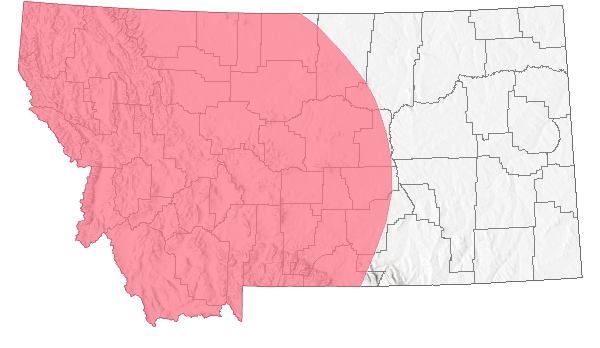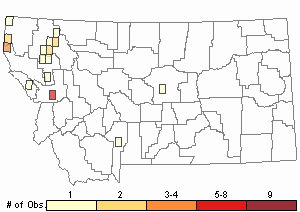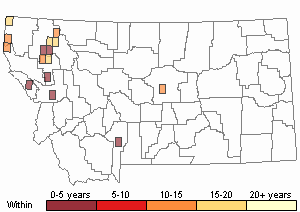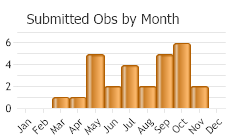View in other NatureServe Network Field Guides
NatureServe
Montana
Utah
Wyoming
Idaho
Wisconsin
British Columbia
South Carolina
Yukon
California
New York
Giant Gardenslug - Limax maximus
General Description
A very large slug, adults reaching 100 mm or more when extended; one of the largest slugs in Montana. Base color is yellowish-gray to brown, with many black spots on the mantle and tail, sometimes merging on the tail into two or three pairs of broken bands; head and sole are paler, tentacles darker. The mantle is 1/4 to 1/3 of the body length, and lacks a notch on the posterior margin. Pneumostome is in the posterior half of the mantle on the right side, and posterior to the mantle cleft. The sole is tripartite (having two longitudinal furrows), the tail is keeled only near the posterior end; the mucous is clear (McDonnell et al. 2009, Hendricks 2012, Burke 2013). Internal anatomy is described by Pilsbry (1948) and Forsyth (2004).
Diagnostic Characteristics
A combination of large size, lack of visceral mantle hump, tripartite sole, lack of keel on tail, and body markings (body with two or three dark lines or rows broken into short stripes or spots; mantle irregularly marked but not striped) separate this species from all others in Montana.
Species Range
Montana Range
Range Descriptions

 Non-native
Non-native
Range Comments
Native to Europe, Asia Minor, and North Africa; introduced to the Americas, Asia and Australia. In Montana, recorded in six counties across the state, mostly west of the Continental Divide, but likely occurs in many others, especially in towns and city parks. Elevation range is 579 to 1196 m (1900 to 3925 ft). First reported in 1951. As many as eight were found at one site in Sanders County in mid-October (Hendricks 2012).
Observations in Montana Natural Heritage Program Database
Number of Observations: 29
(Click on the following maps and charts to see full sized version)
Map Help and Descriptions
Relative Density

Recency



 (Observations spanning multiple months or years are excluded from time charts)
(Observations spanning multiple months or years are excluded from time charts)
Habitat
Inhabits gardens and city parks near water and human habitation, sometimes out of town in campgrounds and valley-bottoms (for example, along Avalanche Creek in Glacier National Park and on Wild Horse Island in Flathead Lake). Forest canopy includes western redcedar, western hemlock, grand fir, Douglas-fir, paper birch, black cottonwood, secondary canopy of alder, willow, dogwood, and snowberry. Most often found under woody debris and leaf litter, sometimes in downed rotten wood or wood piles (Hendricks 2012).
Food Habits
Eats mainly fungus and decaying plant matter, not green plants.
Reproductive Characteristics
Mates while suspended from a mucous thread.
References
- Literature Cited AboveLegend:
 View Online Publication
View Online Publication Burke, T. E. 2013. Land snails and slugs of the Pacific Northwest. Corvallis, OR: Oregon State University Press. 344 p.
Burke, T. E. 2013. Land snails and slugs of the Pacific Northwest. Corvallis, OR: Oregon State University Press. 344 p. Forsyth, R.G. 2004. Land snails of British Columbia. Royal British Columbia Museum: Victoria, British Columbia, Canada. 188 pp.
Forsyth, R.G. 2004. Land snails of British Columbia. Royal British Columbia Museum: Victoria, British Columbia, Canada. 188 pp. Hendricks, P. 2012. A Guide to the Land Snails and Slugs of Montana. A report to the U.S. Forest Service - Region 1. Montana Natural Heritage Program, Helena, MT. vii + 187 pp. plus appendices.
Hendricks, P. 2012. A Guide to the Land Snails and Slugs of Montana. A report to the U.S. Forest Service - Region 1. Montana Natural Heritage Program, Helena, MT. vii + 187 pp. plus appendices. McDonnell, R. J., T. D. Paine, and M. J. Gormally. 2009. Slugs, a guide to the invasive and native fauna of California. University of California Division of Agriculture and Natural Resources Publication 8336. 21 p.
McDonnell, R. J., T. D. Paine, and M. J. Gormally. 2009. Slugs, a guide to the invasive and native fauna of California. University of California Division of Agriculture and Natural Resources Publication 8336. 21 p. Pilsbry, H.A. 1948. Land Mollusca of North America (north of Mexico), Volume II Part 2. The Academy of Natural Sciences of Philadelphia Monograph Number 2(2): 521-1113.
Pilsbry, H.A. 1948. Land Mollusca of North America (north of Mexico), Volume II Part 2. The Academy of Natural Sciences of Philadelphia Monograph Number 2(2): 521-1113.
- Additional ReferencesLegend:
 View Online Publication
View Online Publication
Do you know of a citation we're missing? Frest, T.J. and E.J. Johannes. 2001. An annotated checklist of Idaho land and freshwater mollusks. Journal of the Idaho Academy of Science 36(2):1-51.
Frest, T.J. and E.J. Johannes. 2001. An annotated checklist of Idaho land and freshwater mollusks. Journal of the Idaho Academy of Science 36(2):1-51. Grimm, F.W., R.G. Forsyth, F.W. Schueler, and A. Karstad. 2009. Identifying land snails and slugs in Canada: introduced species and native genera. Canadian Food Inspection Agency, Ottawa, ON. 168 pp.
Grimm, F.W., R.G. Forsyth, F.W. Schueler, and A. Karstad. 2009. Identifying land snails and slugs in Canada: introduced species and native genera. Canadian Food Inspection Agency, Ottawa, ON. 168 pp. Russell, R.H. and R.B. Brunson. 1967. A check-list of molluscs of Glacier National Park, Montana. Sterkiana 26:1-5.
Russell, R.H. and R.B. Brunson. 1967. A check-list of molluscs of Glacier National Park, Montana. Sterkiana 26:1-5.
- Web Search Engines for Articles on "Giant Gardenslug"
- Additional Sources of Information Related to "Snails / Slugs"





